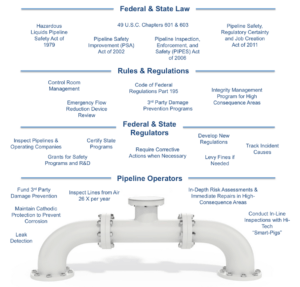
Pipelines operate under many layers of regulation. Comprehensive federal and state laws, rules and regulations, regulators, and operators, all work together to keep pipelines safe.
Federal and state pipeline inspectors regularly evaluate whether operators are being diligent in meeting regulatory requirements, conducting proper inspections, and making necessary repairs.

The U.S. Department of Transportation’s Pipelines and Hazardous Materials Safety Administration (PHMSA) issues pipeline safety regulations that address construction, operation, and maintenance, inspects pipeline operators, and enforces against violations of pipeline safety laws and regulations. PHMSA regulates interstate and intrastate liquids transmission pipelines and interstate natural gas pipelines. PHMSA also approves some state agencies to exercise interstate inspection authority and/or intrastate inspection and enforcement authority. PHMSA regulations address carbon dioxide as a liquid once transported inside a pipe and hydrogen is transported as a gas. As low carbon infrastructure expands, new or revised regulations may be required to ensure safe and reliable operations.
State regulations over intrastate pipelines must be consistent with or more stringent than federal regulations. The National Association of Pipeline Safety Representatives (NAPSR) represents state pipeline regulatory agencies and advances fit-for-purpose regulations to improve pipeline safety.
For more than 100 years, the American Petroleum Institute has been establishing and maintaining standards for the worldwide oil and natural gas industry. These more than 800 standards help the industry operate safely and protect the environment, manufacture superior products, provide critical services, and ensure fairness in the marketplace for businesses and consumers. Standards enhance the safety of industry operations, assure quality, help keep costs down, reduce waste, and provide a consistent framework for the energy industry to reference. They help speed acceptance, bring products to market quicker, and avoid having to reinvent the wheel every time a product is manufactured.

Industry standards and best practices in pipeline construction, operations and maintenance improve safety.
API standards are developed under API’s American National Standards Institute-accredited process, ensuring that the API standards are recognized not only for their technical rigor but also their third-party accreditation which facilitates acceptance by state, federal, and increasingly international regulators. API’s more than 800 standards and recommended practices have been referenced more than 650 times in federal regulations and over 4,000 times in state-based regulations, serving as the model for the oil and gas industry.
API’s published standards cover every aspect of pipeline design, construction, and operations including pipeline integrity; construction, inspection and repair; underground storage; public safety and damage prevention; safety management systems; and high-tech monitoring and control centers.